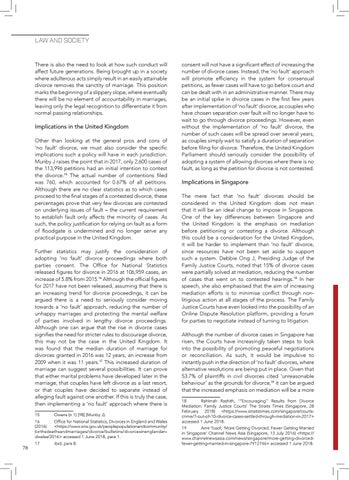LAW AND SOCIETY
There is also the need to look at how such conduct will affect future generations. Being brought up in a society where adulterous acts simply result in an easily attainable divorce removes the sanctity of marriage. This position marks the beginning of a slippery slope, where eventually there will be no element of accountability in marriages, leaving only the legal recognition to differentiate it from normal passing relationships.
Implications in the United Kingdom Other than looking at the general pros and cons of ‘no fault’ divorce, we must also consider the specific implications such a policy will have in each jurisdiction. Munby J raises the point that in 2017, only 2,600 cases of the 113,996 petitions had an initial intention to contest the divorce.15 The actual number of contentions filed was 760, which accounted for 0.67% of all petitions. Although there are no clear statistics as to which cases proceed to the final stages of a contested divorce, these percentages prove that very few divorces are contested on underlying issues of fault – the current requirement to establish fault only affects the minority of cases. As such, the policy justification for relying on fault as a form of floodgate is undermined and no longer serve any practical purpose in the United Kingdom. Further statistics may justify the consideration of adopting ‘no fault’ divorce proceedings where both parties consent. The Office for National Statistics released figures for divorce in 2016 at 106,959 cases, an increase of 5.8% from 2015.16 Although the official figures for 2017 have not been released, assuming that there is an increasing trend for divorce proceedings, it can be argued there is a need to seriously consider moving towards a ‘no fault’ approach, reducing the number of unhappy marriages and protecting the mental welfare of parties involved in lengthy divorce proceedings. Although one can argue that the rise in divorce cases signifies the need for stricter rules to discourage divorce, this may not be the case in the United Kingdom. It was found that the median duration of marriage for divorces granted in 2016 was 12 years, an increase from 2009 when it was 11 years.17 This increased duration of marriage can suggest several possibilities. It can prove that either marital problems have developed later in the marriage, that couples have left divorce as a last resort, or that couples have decided to separate instead of alleging fault against one another. If this is truly the case, then implementing a ‘no fault’ approach where there is 15
Owens (n 1) [98] (Munby J).
16 Office for National Statistics, Divorces in England and Wales (2016) <https://www.ons.gov.uk/peoplepopulationandcommunity/ birthsdeathsandmarriages/divorce/bulletins/divorcesinenglandandwales/2016> accessed 1 June 2018, para 1.
78
17
ibid, para 8.
consent will not have a significant effect of increasing the number of divorce cases. Instead, the ‘no fault’ approach will promote efficiency in the system for consensual petitions, as fewer cases will have to go before court and can be dealt with in an administrative manner. There may be an initial spike in divorce cases in the first few years after implementation of ‘no fault’ divorce, as couples who have chosen separation over fault will no longer have to wait to go through divorce proceedings. However, even without the implementation of ‘no fault’ divorce, the number of such cases will be spread over several years, as couples simply wait to satisfy a duration of separation before filing for divorce. Therefore, the United Kingdom Parliament should seriously consider the possibility of adopting a system of allowing divorces where there is no fault, as long as the petition for divorce is not contested.
Implications in Singapore The mere fact that ‘no fault’ divorces should be considered in the United Kingdom does not mean that it will be an ideal change to impose in Singapore. One of the key differences between Singapore and the United Kingdom is the emphasis on mediation before petitioning or contesting a divorce. Although this could be a consideration for the United Kingdom, it will be harder to implement than ‘no fault’ divorce, since resources have not been set aside to support such a system. Debbie Ong J, Presiding Judge of the Family Justice Courts, noted that 15% of divorce cases were partially solved at mediation, reducing the number of cases that went on to contested hearings.18 In her speech, she also emphasised that the aim of increasing mediation efforts is to minimise conflict through nonlitigious action at all stages of the process. The Family Justice Courts have even looked into the possibility of an Online Dispute Resolution platform, providing a forum for parties to negotiate instead of turning to litigation. Although the number of divorce cases in Singapore has risen, the Courts have increasingly taken steps to look into the possibility of promoting peaceful negotiations or reconciliation. As such, it would be impulsive to instantly push in the direction of ‘no fault’ divorces, where alternative resolutions are being put in place. Given that 53.7% of plaintiffs in civil divorces cited ‘unreasonable behaviour’ as the grounds for divorce,19 it can be argued that the increased emphasis on mediation will be a more 18 Rahimah Rashith, ‘“Encouraging” Results from Divorce Mediation: Family Justice Courts’ The Straits Times (Singapore, 28 February 2018) <https://www.straitstimes.com/singapore/courtscrime/7-out-of-10-divorce-cases-settled-through-mediation-in-2017> accessed 1 June 2018. 19 Amir Yusof, ‘More Getting Divorced, Fewer Getting Married in Singapore’ Channel News Asia (Singapore, 13 July 2016) <https:// www.channelnewsasia.com/news/singapore/more-getting-divorcedfewer-getting-married-in-singapore-7912746> accessed 1 June 2018.
